what are some simple aliases i can add to bashrc file
Alias in bash can exist termed simply equally a command or a shortcut that will run another control/program. Allonym is very helpful when our command is very long and for frequently used commands. Over the course of this commodity, nosotros are going to see how powerful is an alias and the different ways to set upwards an allonym and use information technology.
Cheque Bash Aliases in Linux
Alias is a shell builtin control and you tin can confirm it by running:
$ blazon -a alias allonym is a crush builtin
Before jumping and setting up an allonym nosotros will run across the configuration files involved. An alias can exist set either at the "user-level" or "system level".
Invoke your shell and simply type "allonym" to meet the list of defined alias.
$ alias

User-level aliases tin can be defined either in the .bashrc file or the .bash_aliases file. The .bash_aliases file is to group all your aliases into a separate file instead of putting it in the .bashrc file along with other parameters. Initially, .bash_aliases will not be available and we have to create information technology.
$ ls -la ~ | grep -i .bash_aliases # Check if file is available $ touch ~/.bash_aliases # Create empty alias file

Open the .bashrc file and look out for the following section. This section of lawmaking is responsible for checking if file .bash_aliases is nowadays nether the user home directory and load information technology whenever you lot initiate a new terminal session.
# Allonym definitions. # You lot may want to put all your additions into a separate file similar # ~/.bash_aliases, instead of adding them here directly. # See /usr/share/doc/bash-doc/examples in the fustigate-md parcel. if [ -f ~/.bash_aliases ]; then . ~/.bash_aliases fi

You tin can also create a custom alias file under any directory and add definition in either .bashrc or .profile to load it. But I will not prefer this and I choose to stick with group all my alias under .bash_aliases.
You can also add aliases under the .bashrc file. Look out for the alias department under the .bashrc file where it comes with some predefined aliases.
# enable colour support of ls and also add handy aliases if [ -x /usr/bin/dircolors ]; and then test -r ~/.dircolors && eval "$(dircolors -b ~/.dircolors)" || eval "$(dircolors -b)" alias ls='ls --color=auto' #alias dir='dir --color=machine' #alias vdir='vdir --color=car' alias grep='grep --color=motorcar' alias fgrep='fgrep --color=motorcar' alias egrep='egrep --color=auto' fi # colored GCC warnings and errors #export GCC_COLORS='error=01;31:warning=01;35:notation=01;36:caret=01;32:locus=01:quote=01' # some more ls aliases alias ll='ls -alF' allonym la='ls -A' alias 50='ls -CF' # Add together an "alert" alias for long running commands. Use like so: # sleep ten; alert alias alarm='notify-ship --urgency=depression -i "$([ $? = 0 ] && echo terminal || repeat error)" "$(history|tail -n1|sed -e '\''s/^\southward*[0-nine]\+\s*//;s/[;&|]\southward*alert$//'\'')"'
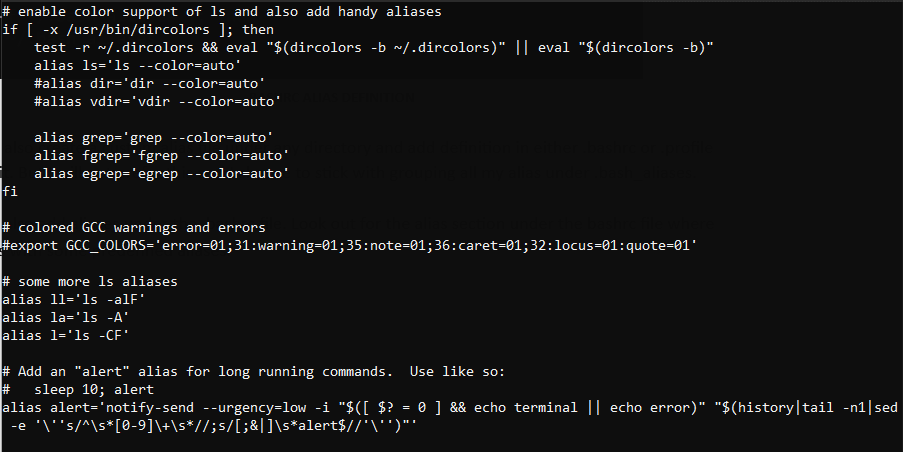
Creating Alias in Linux
Y'all can either create a temporary alias that will be stored only for your current session and will be destroyed one time your current session ends or permanent allonym which will be persistent.
The syntax for creating an alias in Linux.
$ alias <name-of-the-command>="command to run"
For example, in a real scenario.
$ alias Hello="echo welcome to Tecmint"
Open the terminal and create any alias command you desire. If you open some other session then the newly created alias volition not be available.
$ alias Hi"repeat welcome to Tecmint" $ alias $ Hello
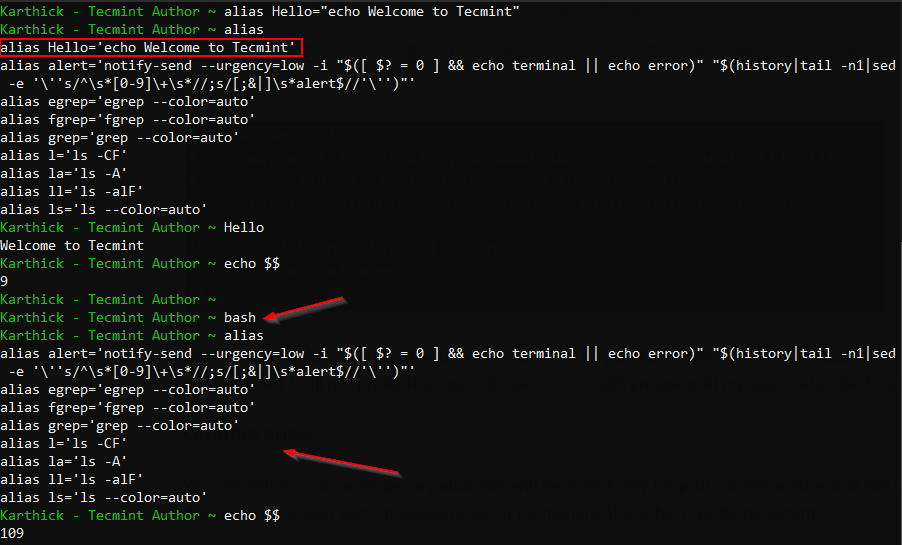
To make the alias persistent, add it to the .bash_aliases file. You can use your favorite text editor or apply the cat command or echo command to add an alias.
$ echo alias nf="neofetch" >> ~/.bash_aliases $ true cat >> ~/.bash_aliases $ cat ~/.bash_aliases

You have to reload the .bash_aliases file for the changes to be effective in the current session.
$ source ~/.bash_aliases
Now if I run "nf" which is an alias for "neofetch" it volition trigger the neofetch program.
$ nf
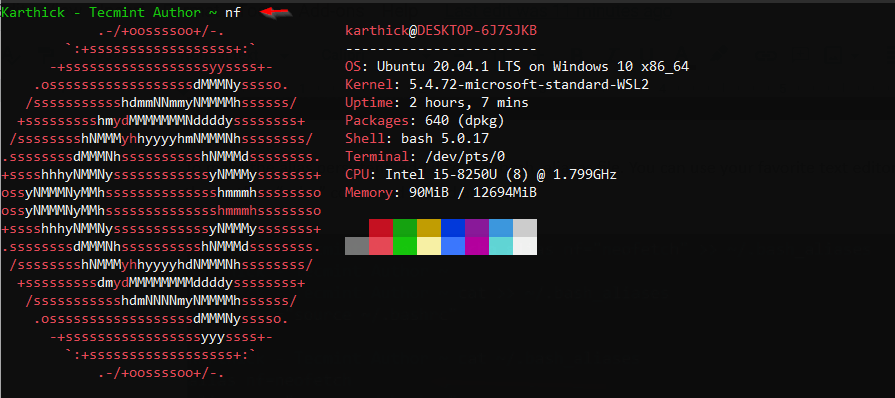
An alias can come in handy if you wish to override the default behavior of any control. For demonstration, I will have an uptime command, that will display organization uptime, the number of users logged in, and the system load boilerplate. Now I will create an alias that will override the behavior of the uptime command.
$ uptime $ true cat >> ~/.bash_aliases alias uptime="echo 'I am running uptime control now'" $ source ~/.bash_aliases $ uptime
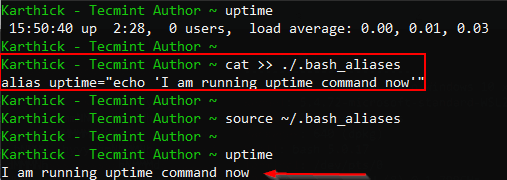
From this case, yous tin can conclude the precedence falls to bash aliases earlier checking and invoking the actual command.
$ true cat ~/.bash_aliases $ source ~/.bash_aliases $ uptime
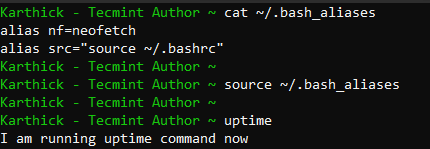
Removing an Allonym in Linux
At present remove the uptime entry from the .bash_aliases file and reload the .bash_aliases file which will notwithstanding print the uptime with allonym definition. This is because the alias definition is loaded into the current beat out session and we accept to either start a new session or unset the alias definition by running the unalias command as shown in the below paradigm.
$ unalias uptime
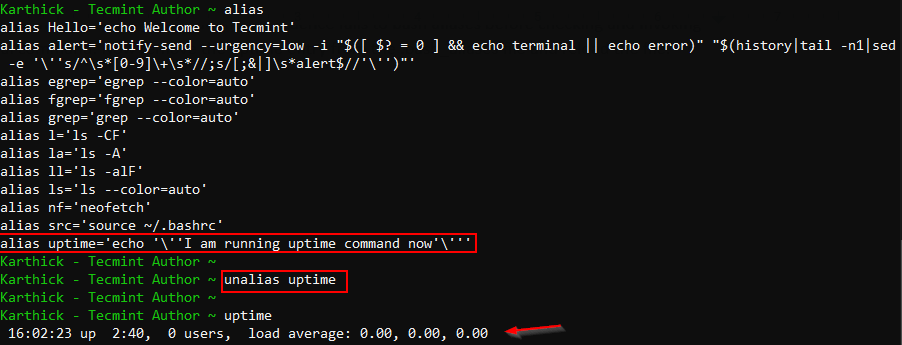
NOTE: Unalias will remove the allonym definition from the currently loaded session, not from .bashrc or .bash_aliases.
Adding System-Wide Aliases
Till this point, nosotros have seen how to gear up an alias at the user level. To fix an alias globally you lot tin can modify the "/etc/bash.bashrc" file and add aliases which will be constructive globally. You lot need to accept the elevated privilege to modify bash.bashrc file.
Alternatively, create a script under "/etc/profile.d/". When you log in to a shell "/etc/profile" volition run whatever script nether profile.d before actually running ~/.profile. This method will reduce the take a chance of messing up either /etc/profile or /etc/fustigate.bashrc file.
$ sudo true cat >> /etc/profile.d/alias.sh alias ls="ls -ltra"
Below is the lawmaking grabbed from the /etc/profile that takes care of running any scripts that we put nether /etc/profiles.d/. Information technology volition expect out for whatsoever files with the .sh extension and run the source command.
$ tail /etc/contour
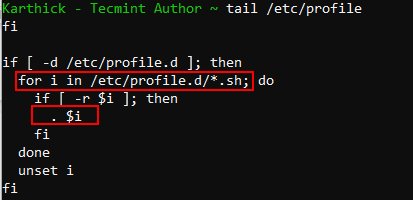
NOTE: It is best practice to take a backup of user-level or system-level files. If in case something went wrong backup re-create tin can exist reverted.
That'southward it for this article. Nosotros have seen what is alias, the configuration files involved with the alias, and dissimilar means to ready the alias locally and globally.
If Yous Appreciate What We Practise Here On TecMint, You lot Should Consider:
TecMint is the fastest growing and nigh trusted community site for whatsoever kind of Linux Articles, Guides and Books on the web. Millions of people visit TecMint! to search or browse the thousands of published manufactures bachelor FREELY to all.
If you like what you are reading, please consider buying us a coffee ( or 2 ) as a token of appreciation.

Nosotros are thankful for your never ending back up.
Source: https://www.tecmint.com/create-and-use-bash-aliases-in-linux/
0 Response to "what are some simple aliases i can add to bashrc file"
Post a Comment